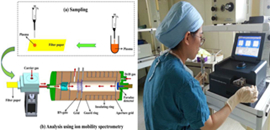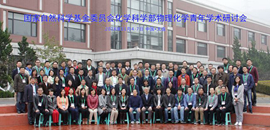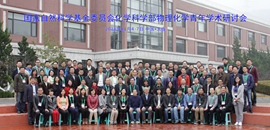Research News
-
 11 22, 2016New Approach Help Detect Propofol with a Drop of Blood in Only One MinuteDalian Institute of Chemical Physics research group led by Prof. LI Haiyang has been committed to the new method and technique research. The improvement of resolution and selectivity technology for IMS promoted its application in clinical practice. Through the cooperation with the First Affiliated Hospital of Harbin Medical University for three years, the rapid analytical detection of the propofol from a drop of blood was realized. In this research, there was no complicated sample pre-treatment with the plasma samples. Each individual measurement could be accomplished within 1 min. Combination medical glass microfiber paper with the gradient thermal desorption technique, the layered thermal desorption of the plasma complex mixtures was realized. These measurement results did meet the clinical application requirements.
11 22, 2016New Approach Help Detect Propofol with a Drop of Blood in Only One MinuteDalian Institute of Chemical Physics research group led by Prof. LI Haiyang has been committed to the new method and technique research. The improvement of resolution and selectivity technology for IMS promoted its application in clinical practice. Through the cooperation with the First Affiliated Hospital of Harbin Medical University for three years, the rapid analytical detection of the propofol from a drop of blood was realized. In this research, there was no complicated sample pre-treatment with the plasma samples. Each individual measurement could be accomplished within 1 min. Combination medical glass microfiber paper with the gradient thermal desorption technique, the layered thermal desorption of the plasma complex mixtures was realized. These measurement results did meet the clinical application requirements.
Propofol is the most commonly used intravenous anaesthetic in the surgery. The target controlled infusion (TCI) devices are used for controlling propofol concentrations in clinical practice. However, the TCI models are not suitable for the personalized medicine. Otherwise, there is a limitation for propofol, excessive or insufficient dosage would lead to serious syndrome of propofol and even death. Therefore, monitoring the propofol concentrations during the surgery is of great significance to enhance the safety of patients. Due to the complicated sample pretreatment, time consuming analysis and delayed response time, it was hard for the current detection instruments to be used in the clinical practice. Nowadays, there is an urgent need for a kind of instrument which can real-time monitor the depth of anesthesia and control the amount of anesthetic precisely.
Dalian Institute of Chemical Physics research group led by Prof. LI Haiyang has been committed to the new method and technique research. The improvement of resolution and selectivity technology for Ion mobility spectrometry (IMS) promoted its application in clinical practice. Through the cooperation with the First Affiliated Hospital of Harbin Medical University for three years, the rapid analytical detection of the propofol from a drop of blood was realized. In this research, there was no complicated sample pre-treatment with the plasma samples. Each individual measurement could be accomplished within 1 min. Combination medical glass microfiber paper with the gradient thermal desorption technique, the layered thermal desorption of the plasma complex mixtures was realized. These measurement results did meet the clinical application requirements.
Furthermore, other clinically-often-used drugs, including remifentanil, flurbiprofen and atracurium, were found no significant interference with the qualitative and quantitative analysis of the plasma propofol. For the plasma propofol concentrations the linear range was from 1 to 12 μg mL-1, while the limit of detection was evaluated to be 0.1 μg mL-1. This result provided certain scientific basis for the anesthetists to adjust the anesthetic dosage and make rational dosage regimen of anesthesia. At the same time, it could help to explain why low or high depth of anesthesia led to the intraoperative knows or medical accidents. Thus, the empirical anesthesia clinical drug use reached a high scientific level. At present, this method and the plasma concentration detector have been developed to the clinical application of demonstration in the First Affiliated Hospital of Harbin Medical University, and compared with the TCI concentration and bispectral (BIS) index. The theory and technology was expected to lead the technical innovation and there was a broad market application prospect.
Figure DICP researchers develop a new method and instrument for propofol concentration detection from a drop of blood (Imaged by WANG Xin and JIANG Dandan)
In this work, there was no complicated sample pre-treatment process, and layered thermal desorption was realized by a drop of blood dropped directly onto the surface of analyzer. This result has been published on Scientific Reports owned by Nature (DOI: 10.1038/srep37525) (Text and Imaged by WANG Xin and JIANG Dandan)
Dr. LU Xinyi
Dalian Institute of Chemical Physics, Chinese Academy of Sciences,
457 Zhongshan Road, Dalian, 116023, China,
Tel: 86-411-84379201,
E-mail: luxinyi@dicp.ac.cn -
 11 22, 2016New Approach Help Detect Propofol with a Drop of Blood in Only One MinuteDalian Institute of Chemical Physics research group led by Prof. LI Haiyang has been committed to the new method and technique research. The improvement of resolution and selectivity technology for IMS promoted its application in clinical practice. Through the cooperation with the First Affiliated Hospital of Harbin Medical University for three years, the rapid analytical detection of the propofol from a drop of blood was realized. In this research, there was no complicated sample pre-treatment with the plasma samples. Each individual measurement could be accomplished within 1 min. Combination medical glass microfiber paper with the gradient thermal desorption technique, the layered thermal desorption of the plasma complex mixtures was realized. These measurement results did meet the clinical application requirements.
11 22, 2016New Approach Help Detect Propofol with a Drop of Blood in Only One MinuteDalian Institute of Chemical Physics research group led by Prof. LI Haiyang has been committed to the new method and technique research. The improvement of resolution and selectivity technology for IMS promoted its application in clinical practice. Through the cooperation with the First Affiliated Hospital of Harbin Medical University for three years, the rapid analytical detection of the propofol from a drop of blood was realized. In this research, there was no complicated sample pre-treatment with the plasma samples. Each individual measurement could be accomplished within 1 min. Combination medical glass microfiber paper with the gradient thermal desorption technique, the layered thermal desorption of the plasma complex mixtures was realized. These measurement results did meet the clinical application requirements.
Propofol is the most commonly used intravenous anaesthetic in the surgery. The target controlled infusion (TCI) devices are used for controlling propofol concentrations in clinical practice. However, the TCI models are not suitable for the personalized medicine. Otherwise, there is a limitation for propofol, excessive or insufficient dosage would lead to serious syndrome of propofol and even death. Therefore, monitoring the propofol concentrations during the surgery is of great significance to enhance the safety of patients. Due to the complicated sample pretreatment, time consuming analysis and delayed response time, it was hard for the current detection instruments to be used in the clinical practice. Nowadays, there is an urgent need for a kind of instrument which can real-time monitor the depth of anesthesia and control the amount of anesthetic precisely.
Dalian Institute of Chemical Physics research group led by Prof. LI Haiyang has been committed to the new method and technique research. The improvement of resolution and selectivity technology for Ion mobility spectrometry (IMS) promoted its application in clinical practice. Through the cooperation with the First Affiliated Hospital of Harbin Medical University for three years, the rapid analytical detection of the propofol from a drop of blood was realized. In this research, there was no complicated sample pre-treatment with the plasma samples. Each individual measurement could be accomplished within 1 min. Combination medical glass microfiber paper with the gradient thermal desorption technique, the layered thermal desorption of the plasma complex mixtures was realized. These measurement results did meet the clinical application requirements.
Furthermore, other clinically-often-used drugs, including remifentanil, flurbiprofen and atracurium, were found no significant interference with the qualitative and quantitative analysis of the plasma propofol. For the plasma propofol concentrations the linear range was from 1 to 12 μg mL-1, while the limit of detection was evaluated to be 0.1 μg mL-1. This result provided certain scientific basis for the anesthetists to adjust the anesthetic dosage and make rational dosage regimen of anesthesia. At the same time, it could help to explain why low or high depth of anesthesia led to the intraoperative knows or medical accidents. Thus, the empirical anesthesia clinical drug use reached a high scientific level. At present, this method and the plasma concentration detector have been developed to the clinical application of demonstration in the First Affiliated Hospital of Harbin Medical University, and compared with the TCI concentration and bispectral (BIS) index. The theory and technology was expected to lead the technical innovation and there was a broad market application prospect.
Figure DICP researchers develop a new method and instrument for propofol concentration detection from a drop of blood (Imaged by WANG Xin and JIANG Dandan)
In this work, there was no complicated sample pre-treatment process, and layered thermal desorption was realized by a drop of blood dropped directly onto the surface of analyzer. This result has been published on Scientific Reports owned by Nature (DOI: 10.1038/srep37525) (Text and Imaged by WANG Xin and JIANG Dandan)
Dr. LU Xinyi
Dalian Institute of Chemical Physics, Chinese Academy of Sciences,
457 Zhongshan Road, Dalian, 116023, China,
Tel: 86-411-84379201,
E-mail: luxinyi@dicp.ac.cn -
 11 18, 2016DICP Advances on 2D Graphene-based Heterostructure Films For High-Performance Flexible Micro-SupercapacitorsThe scientists WU Zhongshuai and BAO Xinhe et al from Dalian Institute of Chemical Physics reported the successful fabrication of stacked-layer heterostructure films (denoted as TP/EG). It is from thiophene (TP) nanosheets and electrochemically exfoliated graphene (EG) for high-rate and flexible micro-supercapacitors (TP/EG-MSCs) with superior rate capability and enhanced volumetric capacitance.
11 18, 2016DICP Advances on 2D Graphene-based Heterostructure Films For High-Performance Flexible Micro-SupercapacitorsThe scientists WU Zhongshuai and BAO Xinhe et al from Dalian Institute of Chemical Physics reported the successful fabrication of stacked-layer heterostructure films (denoted as TP/EG). It is from thiophene (TP) nanosheets and electrochemically exfoliated graphene (EG) for high-rate and flexible micro-supercapacitors (TP/EG-MSCs) with superior rate capability and enhanced volumetric capacitance.
With the dramatic developments of portable and wearable electronics, future energy storage devices become not only thin, light, and cheap, and but also ultraflexible. Micro-supercapacitors exhibit short ion diffusion distance, high power density, superior cycling lifetime, robust mechanical flexibility and safety. They are considered as one competitive alternative to high power sources for full integration into the manufacturing process of electronics.
Two-dimensional (2D) materials, such as graphene and analogous nanosheets (e.g. metal oxides) are becoming a groundbreaking material platform for constructing new flexible planar micro-supercapacitors. They own large surface areas, high mechanical flexibility, ultra-thinness, good electrical conductivity, and high theoretical capacitance (e.g., ~550 F g-1 for graphene). Importantly, planar micro-supercapacitors using graphene and 2D materials can fully utilize the planar device geometry and advantageous features of 2D nanosheets for on-chip energy storage. Moreover, such planar micro-supercapacitors that render electrolyte ions the ability to rapidly interact with all graphene layers in the horizontal direction are superior to conventional sandwich-like stacked devices.
The scientists WU Zhongshuai and BAO Xinhe et al from Dalian Institute of Chemical Physics reported the successful fabrication of stacked-layer heterostructure films (denoted as TP/EG). This film was prepared from thiophene (TP) nanosheets and electrochemically exfoliated graphene (EG) for high-rate and flexible micro-supercapacitors (TP/EG-MSCs) with superior rate capability and enhanced volumetric capacitance. This work has been published online in high-profile Advanced Materials.
Stacked-layer heterostructure films from thiophene nanosheets and electrochemically exfoliated graphene for high-rate and flexible micro-supercapacitors (Imaged by ZHAO Xuejun)
The 2D heterostructure films are produced by alternating deposition of electrochemically EG nanosheets and redox-active conducting TP nanosheets (thickness of 3.5 nm) in sequence, and exhibit large-area uniformity. Notably, the produced films were directly served as binder- and additive-free electrodes for flexible supercapacitors. Remarkably, the resulting microdevice exhibited a pronounced pseudocapacitance contribution with an enhanced volumetric capacitance of more than ~300 F cm-3. Meanwhile, the TP/EG-MSCs can be operated at high rate of up to 1000 V s-1, offering ultrahigh rate capability, as well as unprecedented flexibility under different bending states. This new stacked-layer heterostructures films has an integrated synergetic effect of ultrathin pseudocapacitive TP nanosheets and capacitive EG nanosheets. It can guarantee fast ion diffusion and electron transport throughout the binder-free compact film electrode. It is believed that this strategy of assembling stacked-layer heterostructure films will open up novel possibility for realizing 2D graphene and analogous redox nanosheets for new-concept thin-film energy storage devices. It will hold great promise for powering the integrated circuits.(Text and Imaged by ZHAO Xuejun)
Funder: Ministry of Science and Technology of China, National Natural Science Foundation of China, Natural Science Foundation of Liaoning Province, DICP, ERC Grant on 2DMATER and EC under Graphene Flagship.
Dr. LU Xinyi
Dalian Institute of Chemical Physics, Chinese Academy of Sciences,
457 Zhongshan Road, Dalian, 116023, China,
Tel: 86-411-84379201,
E-mail: luxinyi@dicp.ac.cn
-
 11 18, 2016DICP Advances on 2D Graphene-based Heterostructure Films For High-Performance Flexible Micro-SupercapacitorsThe scientists WU Zhongshuai and BAO Xinhe et al from Dalian Institute of Chemical Physics reported the successful fabrication of stacked-layer heterostructure films (denoted as TP/EG). It is from thiophene (TP) nanosheets and electrochemically exfoliated graphene (EG) for high-rate and flexible micro-supercapacitors (TP/EG-MSCs) with superior rate capability and enhanced volumetric capacitance.
11 18, 2016DICP Advances on 2D Graphene-based Heterostructure Films For High-Performance Flexible Micro-SupercapacitorsThe scientists WU Zhongshuai and BAO Xinhe et al from Dalian Institute of Chemical Physics reported the successful fabrication of stacked-layer heterostructure films (denoted as TP/EG). It is from thiophene (TP) nanosheets and electrochemically exfoliated graphene (EG) for high-rate and flexible micro-supercapacitors (TP/EG-MSCs) with superior rate capability and enhanced volumetric capacitance.
With the dramatic developments of portable and wearable electronics, future energy storage devices become not only thin, light, and cheap, and but also ultraflexible. Micro-supercapacitors exhibit short ion diffusion distance, high power density, superior cycling lifetime, robust mechanical flexibility and safety. They are considered as one competitive alternative to high power sources for full integration into the manufacturing process of electronics.
Two-dimensional (2D) materials, such as graphene and analogous nanosheets (e.g. metal oxides) are becoming a groundbreaking material platform for constructing new flexible planar micro-supercapacitors. They own large surface areas, high mechanical flexibility, ultra-thinness, good electrical conductivity, and high theoretical capacitance (e.g., ~550 F g-1 for graphene). Importantly, planar micro-supercapacitors using graphene and 2D materials can fully utilize the planar device geometry and advantageous features of 2D nanosheets for on-chip energy storage. Moreover, such planar micro-supercapacitors that render electrolyte ions the ability to rapidly interact with all graphene layers in the horizontal direction are superior to conventional sandwich-like stacked devices.
The scientists WU Zhongshuai and BAO Xinhe et al from Dalian Institute of Chemical Physics reported the successful fabrication of stacked-layer heterostructure films (denoted as TP/EG). This film was prepared from thiophene (TP) nanosheets and electrochemically exfoliated graphene (EG) for high-rate and flexible micro-supercapacitors (TP/EG-MSCs) with superior rate capability and enhanced volumetric capacitance. This work has been published online in high-profile Advanced Materials.
Stacked-layer heterostructure films from thiophene nanosheets and electrochemically exfoliated graphene for high-rate and flexible micro-supercapacitors (Imaged by ZHAO Xuejun)
The 2D heterostructure films are produced by alternating deposition of electrochemically EG nanosheets and redox-active conducting TP nanosheets (thickness of 3.5 nm) in sequence, and exhibit large-area uniformity. Notably, the produced films were directly served as binder- and additive-free electrodes for flexible supercapacitors. Remarkably, the resulting microdevice exhibited a pronounced pseudocapacitance contribution with an enhanced volumetric capacitance of more than ~300 F cm-3. Meanwhile, the TP/EG-MSCs can be operated at high rate of up to 1000 V s-1, offering ultrahigh rate capability, as well as unprecedented flexibility under different bending states. This new stacked-layer heterostructures films has an integrated synergetic effect of ultrathin pseudocapacitive TP nanosheets and capacitive EG nanosheets. It can guarantee fast ion diffusion and electron transport throughout the binder-free compact film electrode. It is believed that this strategy of assembling stacked-layer heterostructure films will open up novel possibility for realizing 2D graphene and analogous redox nanosheets for new-concept thin-film energy storage devices. It will hold great promise for powering the integrated circuits.(Text and Imaged by ZHAO Xuejun)
Funder: Ministry of Science and Technology of China, National Natural Science Foundation of China, Natural Science Foundation of Liaoning Province, DICP, ERC Grant on 2DMATER and EC under Graphene Flagship.
Dr. LU Xinyi
Dalian Institute of Chemical Physics, Chinese Academy of Sciences,
457 Zhongshan Road, Dalian, 116023, China,
Tel: 86-411-84379201,
E-mail: luxinyi@dicp.ac.cn
-
 11 10, 2016Young Scientist Symposium on Physical Chemistry was held in DICP
11 10, 2016Young Scientist Symposium on Physical Chemistry was held in DICP
Young Scientist Symposium on Physical Chemistry, organized by the National Natural Science Foundation of China (NSFC), was held in November 4-7 at Dalian Institute of Chemical Physics (DICP). More than 100 young scientists who are funded by the NSFC in recent years as distinguished and excellent young scholars from Chinese universities and research institutions attended the meeting.
At the opening ceremony, Dr. Feixue Gao from NSFC encouraged young scientists to strengthen collaboration and communications, especially in the interdisciplinary fields.Prof. Weihai Fang from Beijing Normal University, Prof. Zhongqun Tian from Xiamen University, Profs. Xueming Yang and Xinhe Bao from DICP gave plenary lectures. The symposium included 48 oral and 21 poster presentations, covering material science, calculational chemistry, theoretical catalysis, bio catalysis, catalytic chemistry, reaction dynamics, membrane science, photocatalysis and characterization techniques.
-
 11 10, 2016Young Scientist Symposium on Physical Chemistry was held in DICP
11 10, 2016Young Scientist Symposium on Physical Chemistry was held in DICP
Young Scientist Symposium on Physical Chemistry, organized by the National Natural Science Foundation of China (NSFC), was held in November 4-7 at Dalian Institute of Chemical Physics (DICP). More than 100 young scientists who are funded by the NSFC in recent years as distinguished and excellent young scholars from Chinese universities and research institutions attended the meeting.
At the opening ceremony, Dr. Feixue Gao from NSFC encouraged young scientists to strengthen collaboration and communications, especially in the interdisciplinary fields.Prof. Weihai Fang from Beijing Normal University, Prof. Zhongqun Tian from Xiamen University, Profs. Xueming Yang and Xinhe Bao from DICP gave plenary lectures. The symposium included 48 oral and 21 poster presentations, covering material science, calculational chemistry, theoretical catalysis, bio catalysis, catalytic chemistry, reaction dynamics, membrane science, photocatalysis and characterization techniques.